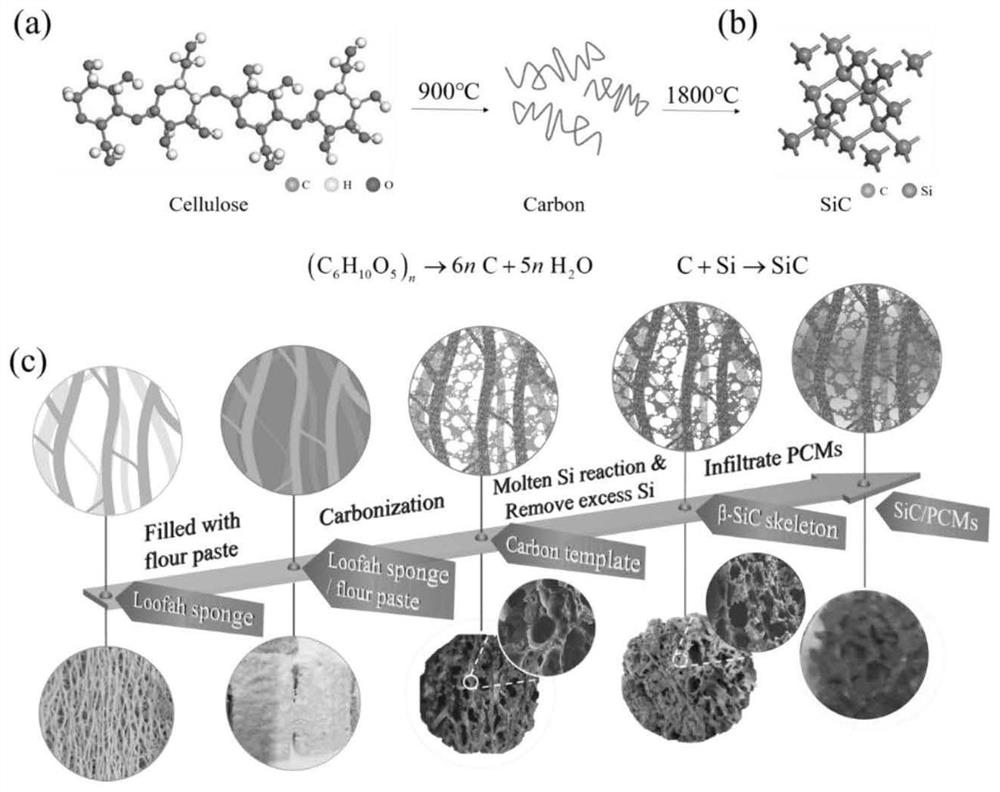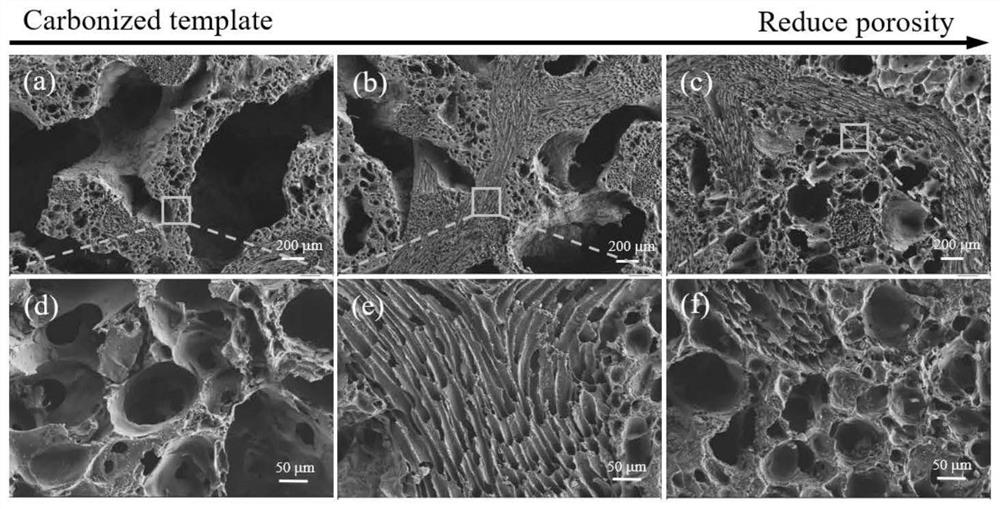Loofah-derived porous silicon carbide ceramic-based high-temperature photo-thermal storage material and preparation method thereof
A technology of porous silicon carbide and storage materials, applied in the direction of ceramic products, heat exchange materials, chemical instruments and methods, etc., can solve the problems that the porosity cannot be automatically adjusted and affects the thermal conductivity and heat storage density of heat storage materials, etc., to achieve The effects of excellent connectivity, improved spectral absorption performance, and improved spectral capture performance
- Summary
- Abstract
- Description
- Claims
- Application Information
AI Technical Summary
Problems solved by technology
Method used
Image
Examples
Embodiment 1
[0033] Step 1: Preparation of porous silicon carbide ceramic framework derived from loofah
[0034] The loofah was washed successively with ethanol solution and deionized water, and then dried in a drying oven. Cut the dried loofah, remove the center of the cylindrical loofah, and keep only the sides of the cylindrical loofah. Dissolve 100g of low-gluten flour in 90mL of deionized water, and stir evenly. The low-gluten flour slurry was filled into the pores of the loofah and dried at room temperature for 48 hours. Then it was placed in a tube furnace for carbonization, and the temperature was raised to 500 °C at a heating rate of 0.5 °C / min in an inert gas atmosphere, and then to 1000 °C at a heating rate of 1 °C / min, and kept for 30 min. The carbonized porous precursor was cut into a cylindrical sample with a diameter of 13±0.3mm by a circular cutting machine, and then cut into a disc-shaped sample with a thickness of 3±0.3mm by a diamond wire cutting machine. Place the cu...
Embodiment 2
[0045] Step 1: Preparation of porous silicon carbide ceramic framework derived from loofah
[0046] The loofah was washed successively with ethanol solution and deionized water, and then dried in a drying oven. Cut the dried loofah, remove the center of the cylindrical loofah, and keep only the sides of the cylindrical loofah. Dissolve 100g of low-gluten flour in 80mL of deionized water, and stir evenly. The low-gluten flour slurry was filled into the pores of the loofah and dried at room temperature for 48 hours. Then it was placed in a tube furnace for carbonization, and the temperature was raised to 500 °C at a heating rate of 0.5 °C / min in an inert gas atmosphere, and then to 900 °C at a heating rate of 1 °C / min, and kept for 30 min. The carbonized porous precursor was cut into a cylindrical sample with a diameter of 13±0.3mm by a circular cutting machine, and then cut into a disc-shaped sample with a thickness of 3±0.3mm by a diamond wire cutting machine. Place the cut...
Embodiment 3
[0052] Step 1: Preparation of porous silicon carbide ceramic framework derived from loofah
[0053] The loofah was washed successively with ethanol solution and deionized water, and then dried in a drying oven. Cut the dried loofah, remove the center of the cylindrical loofah, and keep only the sides of the cylindrical loofah. Dissolve 100 g of cornstarch in 100 mL of deionized water and stir evenly. The cornstarch slurry was filled into the pores of the loofah and dried at room temperature for 48 hours. Then it was placed in a tube furnace for carbonization, and the temperature was raised to 500 °C at a heating rate of 0.5 °C / min in an inert gas atmosphere, and then to 1100 °C at a heating rate of 1 °C / min, and kept for 30 min. The carbonized porous precursor was cut into a cylindrical sample with a diameter of 13±0.3mm by a circular cutting machine, and then cut into a disc-shaped sample with a thickness of 3±0.3mm by a diamond wire cutting machine. Place the cut porous c...
PUM
| Property | Measurement | Unit |
|---|---|---|
| Thermal conductivity | aaaaa | aaaaa |
| Melting point | aaaaa | aaaaa |
| Phase change enthalpy | aaaaa | aaaaa |
Abstract
Description
Claims
Application Information
 Login to View More
Login to View More - R&D
- Intellectual Property
- Life Sciences
- Materials
- Tech Scout
- Unparalleled Data Quality
- Higher Quality Content
- 60% Fewer Hallucinations
Browse by: Latest US Patents, China's latest patents, Technical Efficacy Thesaurus, Application Domain, Technology Topic, Popular Technical Reports.
© 2025 PatSnap. All rights reserved.Legal|Privacy policy|Modern Slavery Act Transparency Statement|Sitemap|About US| Contact US: help@patsnap.com



